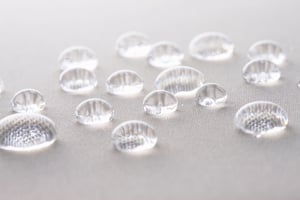You may have heard that when water is no longer repelled by umbrellas or rainwear, it can be...
Factors that Decrease Water Repellency of Rain Jackets
We stated in a previous article that rain jackets do not lose their water repellency if they are not used and stored in a closet. And that there are three factors that can cause a decrease in water repellency.
(1) degradation due to dirt adhesion, (2) degradation due to acclimation to water, and (3) degradation due to abrasion.
In this article, each of these factors will be explained in detail.
(1) Decline due to dirt adhesion
Water repellency is not controlled on the water side, but on the fabric side in the case of rain jackets. The surface tension of the fabric side is controlled. Simply put, it is like coating the surface with a substance that does not get along well with water. In other words, the coated surface is important, but if another substance is attached to that surface, it becomes the surface characteristic of the attached substance. For example, if dirt gets on the coated surface, the characteristics of the coated surface cannot be achieved, and the water repellency will decrease.
(2) Decrease due to acclimation to water
The water repellency of the surface coating described in (1) may decrease even if dirt does not adhere to the surface. This is the property of the coating to blend with water. In fact, this coating is not stable and does not change its properties. If the coating is stiff like the coating on a frying pan, it will not be comfortable to wear, so it is necessary to make it flexible to some extent. This flexibility is a good thing, but it also has a bad thing: it has a tendency to blend in with water. Prolonged contact with water will gradually change the coating so that it becomes friendly with water. This is technically called environmental responsiveness. The degradation due to washing is mainly affected by this environmental responsiveness.
(3) Decrease due to abrasion
Clothing is made by weaving threads, and each thread is made by twisting even finer threads together to make a single thread. The breakage of a woven thread does not occur unless it is damaged to a great extent, but if we look at a more microscopic level, each twisted thread has been damaged. Since lint is the main component of dust in the house, you can imagine how much lint is produced. Clothing is subjected to various frictional stresses when worn, such as sitting on a chair or rubbing against an arm. This causes the surface coating to be removed and a new surface to appear, which reduces the water repellency of the garment.
In the next section, we will discuss how the water repellency can be restored.

.jpeg?height=200&name=AdobeStock_69850861(1).jpeg)

.jpg?height=200&name=vol03(1).jpg)